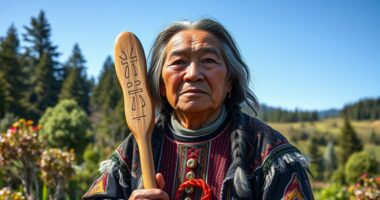To effectively integrate indigenous and English curricula, focus on embedding indigenous languages and cultural content meaningfully into lessons, rather than as add-ons. Collaborate with community elders to develop authentic materials that reflect local traditions and worldviews. Train teachers to handle cultural sensitivities and adapt curricula to local contexts. This approach supports language preservation, cultural pride, and academic success. Keep exploring to discover strategies that balance these opportunities with potential challenges.
Key Takeaways
- Incorporate indigenous languages meaningfully within the curriculum to promote cultural identity and language preservation.
- Collaborate with community elders and speakers to develop authentic, contextually relevant teaching materials.
- Use culturally rooted activities like storytelling, songs, and traditions to encourage active bilingual language use.
- Provide ongoing teacher training to navigate cultural sensitivities and adapt lessons to local linguistic contexts.
- Design flexible curricula that balance linguistic, cultural, and academic goals for inclusive, equitable education.

Bilingual education models are strategies that help students become proficient in two languages simultaneously. These models are particularly essential when integrating indigenous languages with English, as they support both language development and cultural preservation. By designing effective curricula, educators can foster a learning environment where students not only master academic content but also retain their cultural identity. This process requires thoughtful curriculum development that incorporates indigenous languages meaningfully and respectfully, making sure they are not just add-ons but integral parts of the learning experience. When you focus on language preservation within these models, you’re helping to keep endangered languages alive, passing them on to future generations. This effort goes beyond vocabulary and grammar; it involves embedding cultural stories, traditions, and worldviews into the lessons, making language learning a tool for cultural continuity. Regular monitoring of language use and learner progress is vital to ensure the curriculum remains effective and responsive to community needs.
In developing such a curriculum, you need to balance the linguistic needs of students with the cultural richness of indigenous languages. This means collaborating with community elders and language speakers to create materials that reflect authentic usage and cultural nuances. Curriculum development becomes a dynamic process, evolving as you gain deeper insights into the language’s role in community identity. You’ll want to include activities that promote active use of the indigenous language, such as storytelling, songs, and cultural practices, alongside English instruction. This approach guarantees students see the relevance of their heritage language in their education and daily lives. Additionally, integrating indigenous languages into subjects like history, arts, and social studies reinforces their importance and encourages students to value their cultural roots.
Implementing bilingual education models requires ongoing training for teachers, so they can confidently deliver content in both languages and navigate cultural sensitivities. The curriculum should be flexible enough to adapt to local contexts and linguistic variations, recognizing that language preservation isn’t a one-size-fits-all process. When you prioritize curriculum development that respects indigenous languages, you’re helping to create a more inclusive and equitable educational environment. This not only supports language revitalization but also promotes better cognitive and academic outcomes for students. Furthermore, incorporating strategies to manage Bitcoin volatility can serve as a model for balancing challenges and opportunities within educational settings. Ultimately, your goal is to build a bilingual program that honors linguistic diversity, empowers students to become fluent in both languages, and fosters a sense of pride in their cultural heritage. By doing so, you play an essential role in sustaining indigenous languages for generations to come.
Frequently Asked Questions
How Are Indigenous Languages Preserved Within Bilingual Models?
You preserve indigenous languages within bilingual models through language revitalization efforts that actively promote their use in classrooms and community activities. By integrating indigenous languages into curricula, you support cultural continuity, ensuring these languages remain vibrant and relevant. Encouraging students to speak, read, and write in their native languages helps strengthen identity and heritage, ultimately fostering respect and appreciation for indigenous cultures while maintaining linguistic diversity for future generations.
What Challenges Do Teachers Face in Integrating Curricula?
You face challenges in integrating curricula, especially with curriculum alignment issues across languages and subjects. You might struggle to adapt materials that respect Indigenous perspectives while maintaining academic standards. Teacher training is vital; without proper preparation, you may lack the skills to effectively teach bilingual content. Balancing cultural relevance with curriculum requirements requires ongoing support and collaboration, making it essential to prioritize professional development to overcome these hurdles.
How Do Students Balance Learning Two Different Languages?
You balance learning two languages by developing your language proficiency in both, which takes consistent practice and immersion. As you improve, your confidence grows, helping you connect more deeply with your cultural identity. By actively engaging with each language’s unique context, you strengthen your understanding and appreciation of your heritage while effectively communicating in English. This balance enriches your overall learning experience and fosters a strong sense of cultural pride.
Are There Specific Assessments for Bilingual Education Programs?
Yes, there are specific assessments for bilingual education programs. You’ll find standardized testing that measures both general academic skills and language proficiency in each language. These assessments help you track students’ progress in mastering both languages and guarantee they meet curriculum standards. By using these tools, you can identify areas needing extra support, making sure your bilingual program effectively fosters language development and academic achievement in all students.
How Do Parents Influence Curriculum Integration Decisions?
Your involvement as a parent greatly influences curriculum integration decisions by shaping school priorities through your cultural influence and advocacy. When you actively participate in parent-teacher meetings, share your perspectives, and support bilingual programs, you help guarantee that Indigenous and English curricula reflect your community’s values. Your engagement encourages schools to incorporate culturally relevant content, fostering a more inclusive environment that respects and promotes diverse linguistic and cultural identities.
Conclusion
Imagine a young student bridging two worlds, each language a crucial thread in her tapestry of identity. Bilingual education models weave indigenous and English curricula, creating a richer, more inclusive fabric for all learners. Just like a garden flourishing with diverse plants, these programs nurture understanding and pride. Embracing this approach empowers students to thrive in multiple worlds, ensuring that every voice adds strength and beauty to our shared story.
Mary is a passionate writer who brings creativity and a fresh perspective to our team. Her words have the power to captivate and inspire, making her an essential contributor to our content. Mary’s commitment to storytelling and dedication to promoting Indigenous culture ensures that her work touches the hearts of our readers. We’re fortunate to have her as part of our team.









